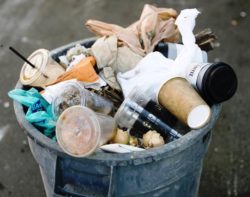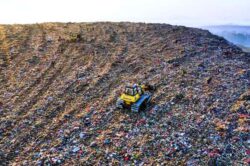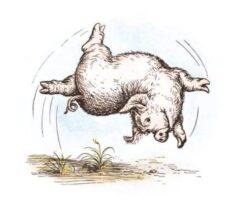Read Time: 6 Minutes Subscribe & Share
Parting Shots
 One of my parting wishes last year when we left for Bologna (I had several, a few not mentionable in polite company), was that CVS would switch to compostable bags. Or at the very least, biodegradable (a conscience-salving but still problematic alternative). Every winter when I walked out of my back gate, I would see a few bright white bags, with their logo in unmistakable red print, entangled in the bare branches of trees lining our sidewalks, too high to reach. They would stay there for months until enough wind would blow their remains away to clog up some other area. We feel better if we grab our shopping items in cloth bags or use disposable utensils that have symbols imprinted on them attesting to our environmental awareness. But it turns out that we don’t understand much about the solutions that compostable and biodegradable technologies offer.
One of my parting wishes last year when we left for Bologna (I had several, a few not mentionable in polite company), was that CVS would switch to compostable bags. Or at the very least, biodegradable (a conscience-salving but still problematic alternative). Every winter when I walked out of my back gate, I would see a few bright white bags, with their logo in unmistakable red print, entangled in the bare branches of trees lining our sidewalks, too high to reach. They would stay there for months until enough wind would blow their remains away to clog up some other area. We feel better if we grab our shopping items in cloth bags or use disposable utensils that have symbols imprinted on them attesting to our environmental awareness. But it turns out that we don’t understand much about the solutions that compostable and biodegradable technologies offer.
Here To Stay
Plastics are a fossil fuel end-product and are not going to disappear from our lives. Once its molecules are transformed into a polymer, it’s here to stay. In fact, more petrochemical plants are planned by the industry to feed an increasing need for plastic. Medical sanitation, the food industry, and much of our clothing require it. If you look at the term “biodegradable,” its meaning, according to an unusually candid German packaging distributor, tells the truth.
meaning, according to an unusually candid German packaging distributor, tells the truth.
Biodegradable refers to the disposal of the materials. A plastic may be called biodegradable if it decomposes into water and carbon dioxide within an unspecified time due to biological processes. However, this does not include statements about the production of the plastic: This does not have to be based on biological materials.
Most plastics marked biodegradable end up in landfills, and unless the item you are discarding is marked “landfill biodegradable,” it must go into a waste management site that handles both biodegradable and compostable materials. The actual petroleum-based polymer does not disappear, but must be recycled in some way. They can only be fragmented and used in a different way – in other words, cycled for a new purpose such as being turned into a recycled polyester fabric.
Into The Air
From what I have been reading, at best our traditional biodegradable plastics take about three years to somewhat disappear if exposed to light and oxygen; and there exist newer versions that degrade in less time. But if they are in a landfill, it can take centuries before they biodegrade, but still with the polymers intact. The truth is that tons of plastics are not in the right circumstances to degrade and are consumed by the animals we eat; thus we ingest these polymers too. Peer-reviewed scientific studies show that there are health risks to be considered.
Compostable plastic is a new step forward, and it requires some knowledge and effort by individuals and governments to make the concept work. The definition of compostable accepted by the US and Canada, as well as EU countries is:
That which is capable of undergoing biological decomposition in a compost site such that the material is not visually distinguishable and breaks down into carbon dioxide, water, inorganic compounds and biomass at a rate consistent with known compostable materials.
The trick is that these compostable containers, bags, utensils must be disposed of in a specific way for this technology to work. An item marked compostable is compostable only if it is addressed in a waste management system that handles composting. It does not mean that it disappears into the earth or water on its own. But if properly handled, instead of being incinerated with traditional waste, which is usually what happens, unlike biodegradable plastics it leaves nothing that can be recycled for further use.
The third part of the equation is recycling – such as the efforts in Alexandria with glass, and paper, or organic waste that can be turned into a soil enricher. This takes waste and turns it into new products: recycled plastics, fabrics, cardboard and paper products, for example. But in the end, we need to produce less waste and that may be helped by PAYT.
Pay As You Throw
 When we moved to Italy, we were made abruptly aware of the commitment it takes for families as well as local and notional governments to manage waste in a sustainable way. In Bologna, over a decade ago a formal decree was made in keeping with EU requirements that all trash had to be separated into the following bins at home: paper and cardboard, plastics, organic waste, glass and metal, and finally “indifferent trash” — that which cannot be included in any of the preceding definitions. Plus, used cooking oil is designated for yet another waste management station. There is currently no individual trash pick up in Bologna as there is in Alexandria. You take your separated waste to the substation nearest your home (and there are plenty of substations) and deposit each bag or stack in the appropriate dumpster.
When we moved to Italy, we were made abruptly aware of the commitment it takes for families as well as local and notional governments to manage waste in a sustainable way. In Bologna, over a decade ago a formal decree was made in keeping with EU requirements that all trash had to be separated into the following bins at home: paper and cardboard, plastics, organic waste, glass and metal, and finally “indifferent trash” — that which cannot be included in any of the preceding definitions. Plus, used cooking oil is designated for yet another waste management station. There is currently no individual trash pick up in Bologna as there is in Alexandria. You take your separated waste to the substation nearest your home (and there are plenty of substations) and deposit each bag or stack in the appropriate dumpster.
You also pay for your grocery bags at the checkout (and they are all compostable plastic), and most everyone stashes a shopping bag or two in their man or woman purse – the RWM so far has refused to have a man purse. If you use your own shopping cart, which I now do (they are everywhere) most people just put their groceries in without bags. I see a lot more paper and cardboard containers here and far fewer rigid plastic ones. Cigarette butts are a different matter – there are considerably fewer in the US than in Italy – and they are not biodegradable and leach toxins into the ground and waterways.
I think the EU plan is ultimately going to be similar to one used in some countries, or even municipalities, where you use an identity card (similar to the magnetic key card used at hotels) to unlock a waste-specific dumpster. Each dumpster records your waste “deposit” and ultimately you are charged for how much waste is in your account – a sort of “polluter pays” system. Several countries in Asia have implemented PAYT programs and from the areas that have implemented PAYT, and according to sources used by Wikipedia, it has resulted in residential waste declining from 9 – 38%, with recycling increased from 6 – 40%.
When you consider that the average person in the US uses 300-400 plastic bags per year, while the average in Denmark is 4 plastic bags per person annually, we have a lot to learn. I have been forced to rethink how I buy groceries, and shopping in general. I separate plastic tags and containers from the paper ones, ditto strings for the bins under the kitchen sink, and reuse both plastic and paper bags until they are in shreds. Some aspects
the average in Denmark is 4 plastic bags per person annually, we have a lot to learn. I have been forced to rethink how I buy groceries, and shopping in general. I separate plastic tags and containers from the paper ones, ditto strings for the bins under the kitchen sink, and reuse both plastic and paper bags until they are in shreds. Some aspects were inconvenient, but I am learning and am much more conscious of how to conserve and perhaps also address the next issue – food waste. While I loved Wilbur in the classic “Charlotte’s Web” and admired the Castello dei Polli in the Bertrand backyard – I don’t see pigs and chickens as my answer.
were inconvenient, but I am learning and am much more conscious of how to conserve and perhaps also address the next issue – food waste. While I loved Wilbur in the classic “Charlotte’s Web” and admired the Castello dei Polli in the Bertrand backyard – I don’t see pigs and chickens as my answer.

Kitchen Detail shares under the radar recipes, explores the art of cooking, the stories behind food, and the tools that bring it all together, while uncovering the social, political, and environmental truths that shape our culinary world.




Comments are closed here.
Follow this link to create a Kitchen Detail account so that you can leave comments!